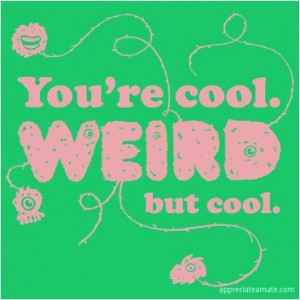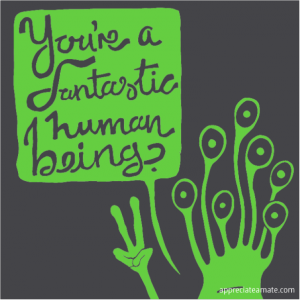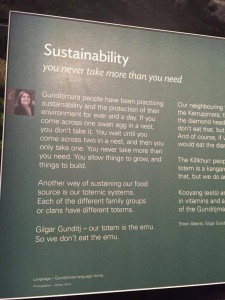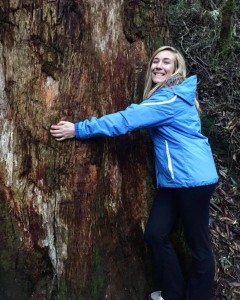The app @ppreciate a Mate, was created with practice foundations of psychologist Alikki Russell and experiences of Emma Kuhlman during her time as a youth worker. Most importantly, this app was reviewed by the population it intends to target. Two of the young people affiliated with ReachOut.com, Chelsea and Doris, provided feedback on the pros and cons of the app.
The app focuses on a fun platform to promote positive communication between young people. The interface lets you personalize and design a compliment, then deliver it by any means of social media. By engaging the user in the decision making process, the app feels more genuine.
Of course, for “research” we decided to play on the app! A lightbulb went off, and we decided to create a compliment for each other, and then show each other what we came up with at the same time. Not surprisingly, we became very focused on picking the right message, and the right style and color. Somewhat surprisingly, each of our compliments had the same message of “embrace being you.” The compliments range from “I like your face” type messages to “Stay strong” and positive reinforcements.
Alex’s compliment to Kayla:
Alex – I choose this for Kayla, because I always tell Kayla my favorite thing about her is her weirdness. I love weirdness; it’s the best. Kayla is weird and she is also the best! I saw this and thought to myself, THIS IS THE ONE FOR KAYLA.
Kayla’s compliment to Alex:
Kayla: As soon as I saw this one, I thought “yup- this is Alex, because really she is a fantastic human being!” Really though, I tell her all the time that she is a fantastic human because she has such a wide range of knowledge and experience and I really appreciate how she manifests that into being the fantastic person that she is.
What we loved about the app (aside from the fun colors!) was that when we were sharing why we picked the compliment for each other, there was a real genuine moment when we realized how much we appreciate each other. We didn’t know each other before this trip, and the compliment kind of opened the door for us to have an honest conversation where we both just said “THANK YOU” – it’s nice traveling around in the land of OZ with a buddy who embraces your weirdness.
What is most important in sharing these messages is sustaining the positivity that it creates. Young and Well focuses on this by creating more apps and continuing multiple research projects on the mental health of youth. Australia is pretty keen on sustainability, which is something that we both very much appreciate. Aside from sustaining the mental health of their citizens young and old, they focus on the environmental sustainability of their glorious country.
Options in Sustainability
One thing that has been on our minds has been this quote from the Aboriginals Gunditjmara people:
The part that resonates with us is the “you never take more than you need.” This concept is one that is uncommon in the states. We are very used to “take as much as you can!”
Considering we both air on the “tree hugging hippie” side of environmental factors, sustainability is something that has really stuck out to us.
We have continued to notice more and more ways Australia is focusing on sustaining the environment. For example, there are always recycling bins next to garbage cans and there are clear directions on what should and should not go in each. The pictures designating appropriate materials are understandable in all languages and cultures, which enables more recycling to take place. Every toilet has two flushing options, one of which saves water when a full flush is not necessary. Water is quickly becoming our most valued resource and little things like this could have a long-term impact of cutting down on clean water pollution. The art culture is rich here, and it is common to see temporary art exhibits use cardboard informational displays so that they may be recycled afterwards, whereas in the U.S. we are more accustomed to seeing non-recyclable materials used. Almost all souvenir shops have a reusable bag as an add- on purchase for only a dollar or two. Grocery stores encourage the use of these reusable bags, and remind you at multiple points that you should be using them. The ease and access of these bags on top of the cool designs make reusable bags almost “trendy” here.
You don’t have to look far around here to see a sign or campaign promoting some sort of environmental sustainability. Some ads we’ve noted include advertisements in wildlife centers, rainforests, and outdoor eating spaces, the “keep wildlife wild” campaign, and directions on proper interactions with Australia’s very own wild life. Even within the natural eco system, the Australian people are aware of sustainability. In the wildlife areas, there are numerous signs explaining why not to do something. The wildlife areas have emus and it is normal to want to feed the baby emu to get it to come closer; however, a sign explains that feeding baby emus turns them into aggressive adults who harass humans. Just knowing “you can’t” is often not enough. Removing the barriers and helping people understand why it is important for environmental sustainability.
While visiting the Great Ocean Road, we learned about the environmentally friendly practice of moving koalas. This is to ensure the continued health of the gum trees they were living off of, as over populated koalas will eat too much, effectively killing their food source. We also learned about the practice of controlled fires in the bush to renew the soil and allow plants to breathe.
Adding to the fact Melbourne lends itself to making recycling and environmentally friendly practices second nature, Melbourne makes contribution to sustainability easier. There are multiple ways to contribute to sustainability on a near-daily basis. Every place that we have visited has a variation of a donation box. There are donation boxes at museums/aquariums, wildlife centers and zoos; campaigns to raise awareness, and options to round up your price while checking out to donate. These practices are apparent in the U.S.; the difference is the quantity and the explanation. Everything here has an explanation of why or what you are donating to and helping.
One thing that was hard to get use to, but is brilliant, is an outlet switch. The outlet switches turn the electricity to each individual outlet off, which saves even more electricity and is more environmentally friendly. Appliances give you options to be more efficient in energy usage (dishwashers have multiple levels depending on what you’re washing, clothes washers have a specific option to add more water if you insist upon it). This is very much the same concept with the toilet flushing: only use as much as you need.
Transportation! Obviously, this one is huge. Public transportation is widely used; trams, trains, and buses are just a way of life in Melbourne. Tram use is encouraged by the government through the installation of a free transportation zone, which is easily accessed as it sits directly in the center of the Central Business District. We feel the U.S. would change higher prices on public transport in the most opportune location, as it is more highly trafficked. The tram and train cards that are used outside the free zone (Myki cards) are stronger and can be reused and topped up, rather than ones like NYC Metro Cards that fall apart and are thrown away without thought. To add on to the transportation curbing the carbon footprint, there are far less semi trucks in use; utes are more environmentally friendly than US pickup trucks, as they are made from 2-wheel drive vehicles rather than gas-guzzling 4-wheel drive pickups.
As social workers, all this stuff is notable and important to us. The biggest thing in working in practice is learning how to work around or remove barriers. It is not just that Australia provides more options to practice environmentally friendly practices – it’s that Australia works to remove barriers to increase the probability of environmental protection. For example, with CLEAR directions on recycling and a recycling bin next to the trashcan, recycling becomes second nature. During our trip to the Great Ocean Road, we really tapped into mindfulness and setting intentions. Sustainable practices come from being mindful of what you are doing. We learned how setting positive intentions sets you up to succeed, and we can see the similarity in how Australia’s environmental intentions set the country up for sustainability. We decided to set a positive intention for this week. Well two, really:
- Allow compliments and conversations to open genuine and shared moments.
- Follow the word of the Gunditjmara people, and “never take more than you need”, because sustainability requires mindfulness.




